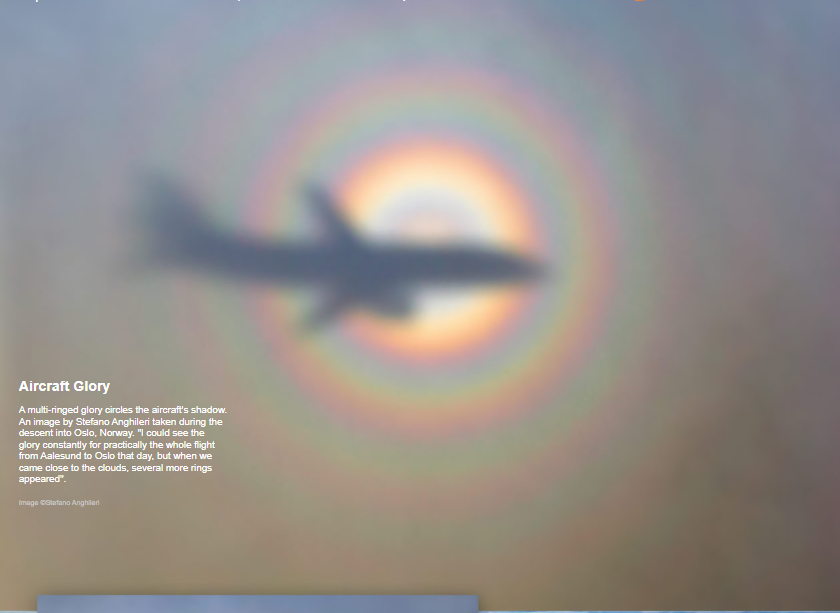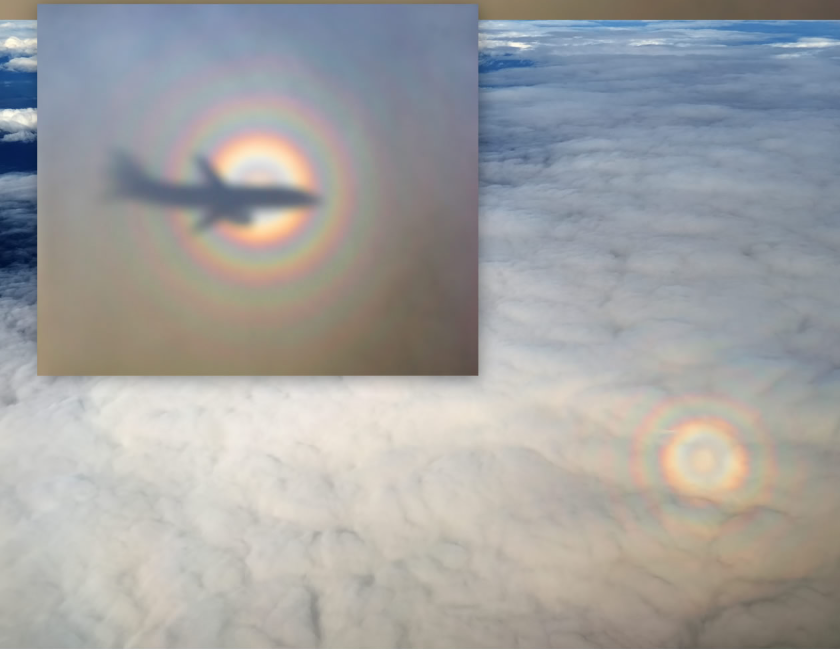OPOD - Glory
OPOD - Glory: A Spectacular Atmospheric Phenomenon
Have you ever gazed out the window of an airplane and been captivated by a stunning optical display? One such phenomenon is known as a glory, which forms when sunlight interacts with water droplets or small ice crystals in the atmosphere. In this blog post, we will delve deeper into the fascinating world of glories, exploring their formation, characteristics, and the awe-inspiring experiences they offer to those lucky enough to witness them.
The Basics of a Glory
A glory is a circular optical phenomenon that appears as a series of concentric colored rings surrounding the shadow of an observer. It is often observed from high altitudes, such as on airplanes or mountaintops. The rings of a glory result from the diffraction and interference of sunlight by tiny water droplets or ice crystals suspended in the air.
The Formation Process
To understand how a glory forms, we must first examine the interaction between light and the microscopic particles in the atmosphere. When sunlight encounters these particles, it undergoes diffraction, bending around them and creating a circular pattern of light. Additionally, interference occurs when the diffracted light waves overlap and either reinforce or cancel each other out, resulting in the distinct rings of a glory.
The size of the droplets or crystals responsible for glory formation is crucial. Typically, glories arise from droplets with diameters between 10 and 30 micrometers or ice crystals with sizes less than 30 micrometers. These particles must be uniformly distributed within a cloud or fog layer for a glory to appear.
The Colorful Rings of a Glory
The rings of a glory are characterized by vibrant colors, with red on the outside and blue on the inside. This color sequence is a result of the diffraction process, where shorter wavelengths (blue light) are diffracted at larger angles than longer wavelengths (red light). As a result, the red light is observed at a greater distance from the shadow, while the blue light is seen closer to it.
Multiple Rings and Brocken Spectres
In certain conditions, a glory can exhibit multiple rings, creating a mesmerizing spectacle. The number of rings depends on factors such as the size and distribution of the droplets or crystals. The more uniform the distribution, the greater the number of rings that will be visible. These additional rings add complexity and beauty to the already captivating phenomenon.
Sometimes, when a glory is observed from an airplane, a related phenomenon known as a Brocken spectre can also be seen. A Brocken spectre occurs when the observer's shadow is cast onto a cloud or fog layer below, creating a magnified and elongated shadow surrounded by a halo. This ethereal sight is a wonderful complement to the glory, intensifying the enchantment of the experience.
Experiencing a Glory
Witnessing a glory is a truly awe-inspiring experience that leaves a lasting impression. Imagine being on an airplane, looking out the window, and seeing these vibrant rings of light encircling your own shadow. It's a moment of wonder and appreciation for the natural world's ability to create such breathtaking displays.
While glories can be seen from various high-altitude vantage points, such as mountaintops or airplanes, they are most commonly observed when flying above clouds or in misty conditions. The moisture-laden atmosphere provides the perfect conditions for droplets or crystals to form and interact with sunlight, resulting in the formation of glories.
Capturing Glories through Photography
Photographing a glory can be challenging due to its ever-changing nature. However, with patience and the right equipment, capturing this elusive phenomenon can result in stunning images. To photograph a glory, it is recommended to use a wide-angle lens to capture the entire circular shape and ensure proper focus. Additionally, adjusting the exposure settings to balance the brightness of the glory with the surrounding sky can help bring out the vibrant colors.
The Scientific Significance
Beyond their aesthetic appeal, glories also have scientific significance. By studying the formation and characteristics of glories, scientists can gain valuable insights into the properties of atmospheric particles, such as their size and distribution. This information contributes to our understanding of cloud physics and aids in the development of climate models.
In Conclusion
Glories are captivating atmospheric phenomena that showcase the intricate interplay between light and microscopic particles in the atmosphere. Their circular rings of vibrant colors create a spectacle that enchants and mesmerizes those fortunate enough to witness them. Whether observed from an airplane or a mountaintop, glories offer a glimpse into the beauty and complexity of the natural world. So, next time you find yourself soaring above the clouds, keep an eye out for this remarkable optical phenomenon and prepare to be amazed by the glory that awaits you.

Aircraft Glory
A multi-ringed glory circles the aircraft's shadow. An image by Stefano Anghileri taken during the descent into Oslo, Norway. "I could see the glory constantly for practically the whole flight from Aalesund to Oslo that day, but when we came close to the clouds, several more rings appeared".
Image ©Stefano Anghileri


Note: this article has been automatically converted from the old site and may not appear as intended. You can find the original article here.
Reference Atmospheric Optics
If you use any of the definitions, information, or data presented on Atmospheric Optics, please copy the link or reference below to properly credit us as the reference source. Thank you!
-
<a href="https://atoptics.co.uk/blog/opod-glory/">OPOD - Glory</a>
-
"OPOD - Glory". Atmospheric Optics. Accessed on November 26, 2024. https://atoptics.co.uk/blog/opod-glory/.
-
"OPOD - Glory". Atmospheric Optics, https://atoptics.co.uk/blog/opod-glory/. Accessed 26 November, 2024
-
OPOD - Glory. Atmospheric Optics. Retrieved from https://atoptics.co.uk/blog/opod-glory/.